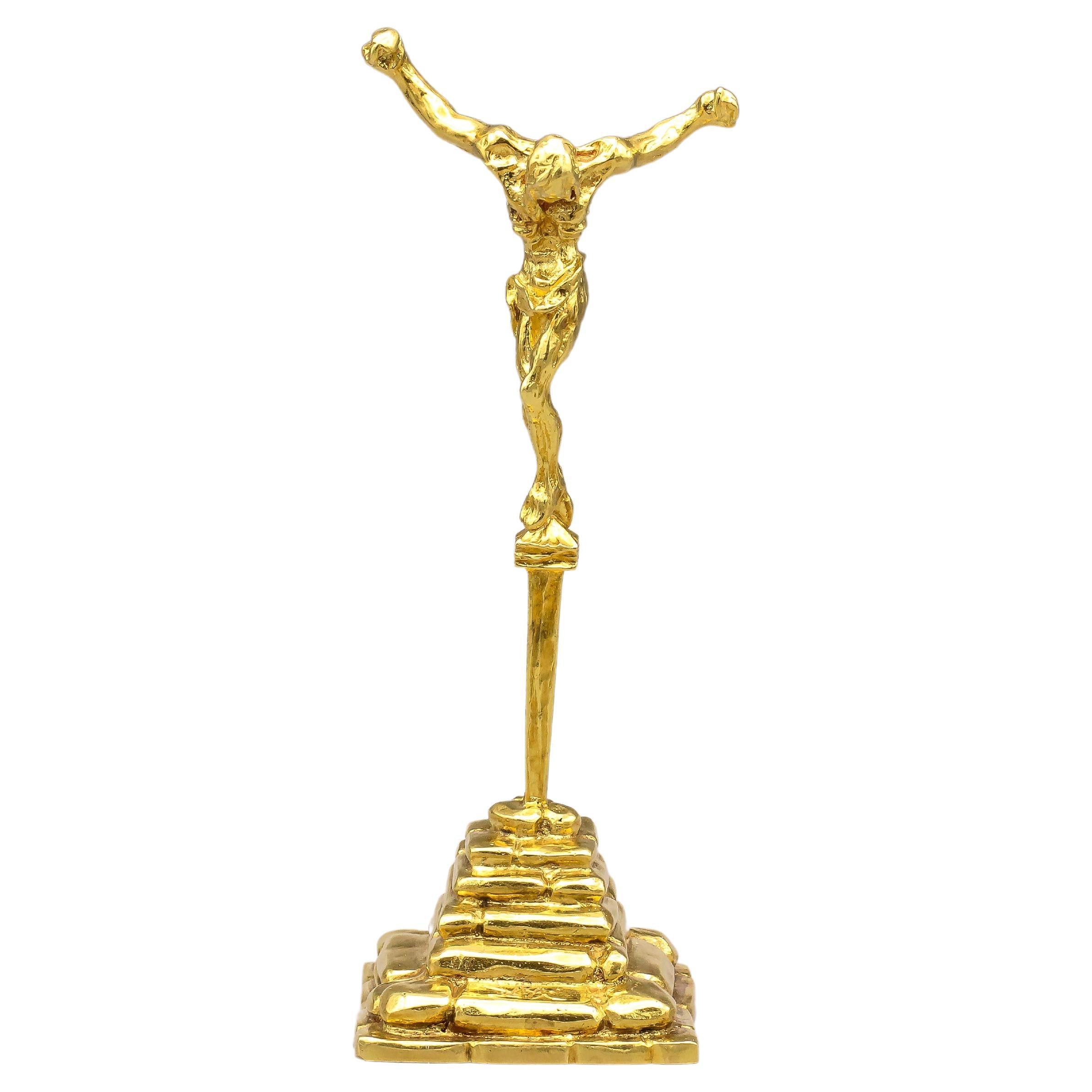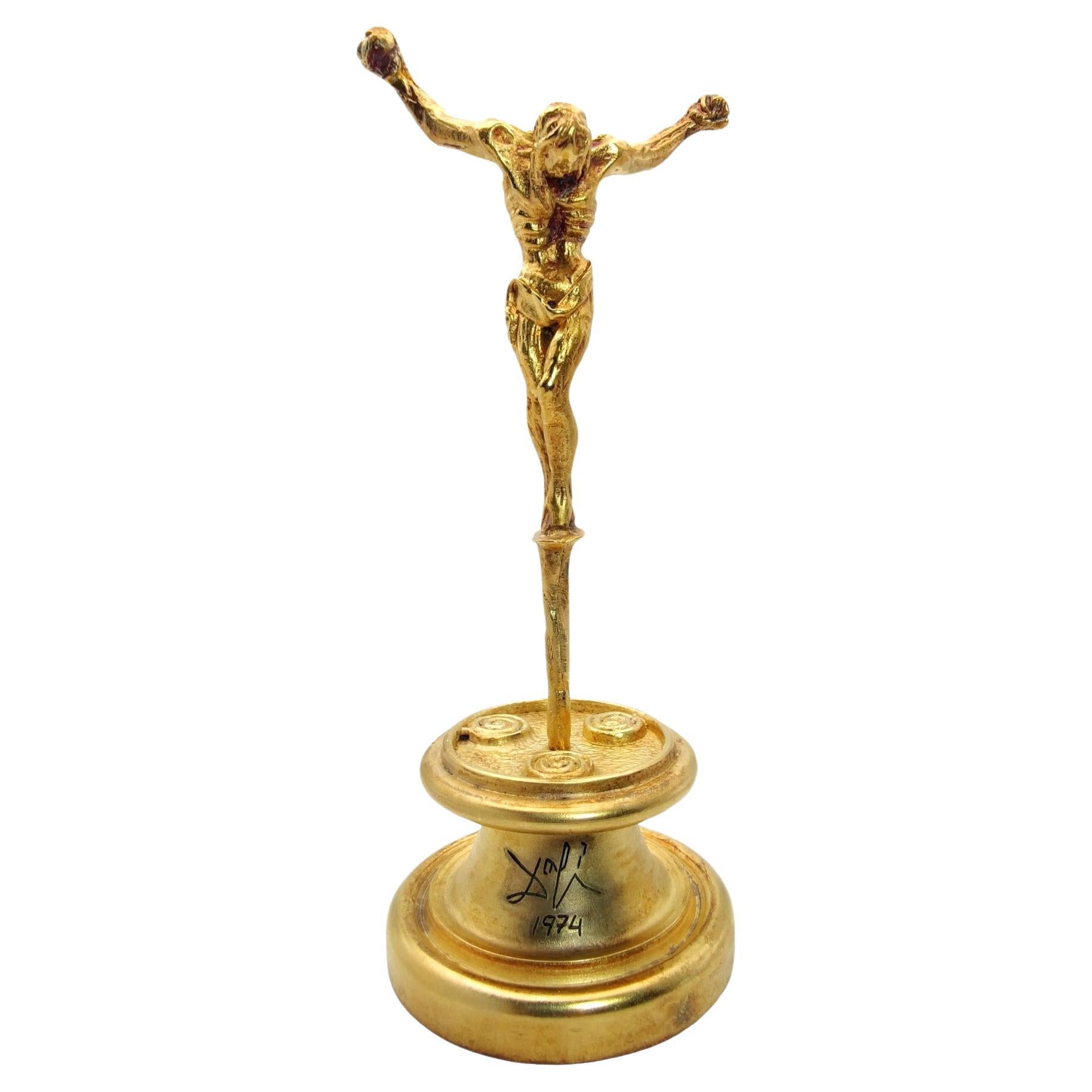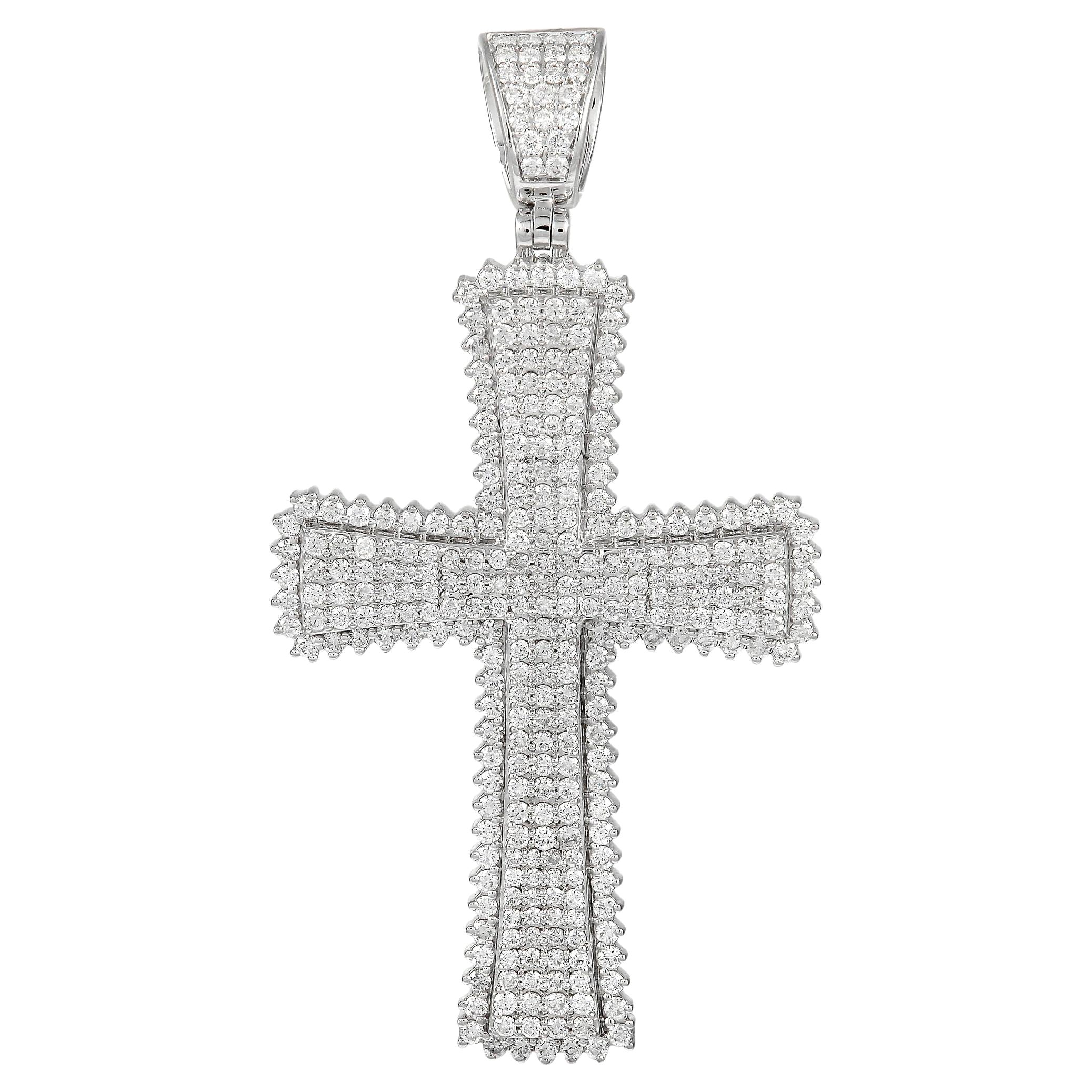Items Similar to Fifteenth Century Reliquary Pendant with Christ on the Cross
Video Loading
Want more images or videos?
Request additional images or videos from the seller
1 of 6
Fifteenth Century Reliquary Pendant with Christ on the Cross
About the Item
Reliquary Pendant with Christ on the Cross
Germany, c. 1480–1500
Gilded silver
Weight 35 grams; dimensions 69 × 46 × 8 mm
A mixture of forms gives this pendant a rare expressiveness. At its core is a hinged rectangular box that likely once contained a relic fragment (the interior is gilded to match the shining exterior).
A tiny sculpture of the crucified Christ attached to the front surface of the box occupies the center of a minimalist composition representing the Crucifixion on the mount of Golgotha. As it typically does in Gothic and German renderings, the figure of Christ slumps down, hanging from painfully stretched arms. The tiny body, however, is elegant in its twisting angular collapse. It surely received repeated, attentive devotion from pendant’s owner and the surface is extensively rubbed. The face is obliterated, and only a few details of strained muscles of the left arm and ribcage are still visible in what once must have been a detailed and sensitive rendering of Christ’s body.
An engraved, flat depiction of the empty cross on the pendant’s back is less worn. The cross-hatched background recedes to let the surface of the shining cross emerge; the engraved drops of blood reiterate the story of Christ’s suffering and death (and repeat these same blood drops as on the front).
Elaborate floriated arms extend the reach of the box’s cross imagery into elegant vegetal forms that not only echo the cross but also convey its fecund and life-giving qualities, a common symbol in images of the Crucifixion.
The German artist relied on forms in his artistic sphere for this exuberant curling and growing leaf form. The foliage resembles a study of a leaf in an engraving by Martin Schongauer (ca. 1430–1491) in which the artist combines acanthus-like forms with the stem and vines of a grape plant. The pendant’s leaf forms may reference the Eucharistic symbolism of the grape but the repeated Trinitarian three-leaf shape also emphasizes the sacred nature of the image. Through its artistic “flourish,” the ornament reinforces and literally extends the piece’s meaning.
The centerpiece of this gilded silver pendant is a flat rectangular box engraved on both sides with a cross on Golgotha Hill against a cross-hatched background. On the front panel is the figure of Christ on the Cross in high relief. The backplate is hinged and, when opened, reveals a compartment for relics (the hinge pin missing). The cross form is emphasized by four trefoil-shaped arms with Gothic foliage.
Comparisons and Literature: This rare reliquary pendant is probably German. The design and details, such as the Gothic foliage, suggests that the goldsmith was inspired by the prints of Martin Schongauer (c. 1430/50-1491) and Master E.S. (c. 1450-1467); cf. exh. cat., Ornemanistes du XVe au XVIIe siècle 1987, nos. 8-9 and 10-13; Berliner 1925, vol. 1, figs. 5-10. This style of foliage can be found on various reliquaries and vessels of the period between 1480 and 1500, even on the print of an incense holder designed by Schongauer; see Fritz 1982, cat. no. 611, and further example of the period, cat. no. 760. The Christ figure with deeply angled legs is also reminiscent of depictions in Master E.S. and Schongauer prints; see Höfler 2007, figs. 30 and 32, 195.
- Metal:
- Weight:35 g
- Dimensions:Width: 1.82 in (46 mm)Depth: 0.32 in (8 mm)Length: 2.72 in (69 mm)
- Place of Origin:
- Period:
- Date of Manufacture:c.1480-1500
- Condition:Wear consistent with age and use.
- Seller Location:Chicago, IL
- Reference Number:
About the Seller
5.0
Vetted Seller
These experienced sellers undergo a comprehensive evaluation by our team of in-house experts.
Established in 1991
1stDibs seller since 2021
5 sales on 1stDibs
Typical response time: 13 hours
- ShippingRetrieving quote...Ships From: Chicago, IL
- Return PolicyA return for this item may be initiated within 3 days of delivery.
More From This SellerView All
- Antique Double Sided Rosary Bead with Head of Christ and Skull Carved in BoneLocated in Chicago, ILROSARY BEAD WITH WENDEKOPF Germany, 16th century Bone Weight 12 grams; dimensions 29 × 23 × 24 cm A double-sided bead made of bone with a finely carved head of Christ on one side an...Category
Antique 16th Century German Figurines and Sculptures
- Antique Spanish Jet Amulet Pendant with FigaLocated in Chicago, ILAMULET PENDANT WITH FIGA Spain, c. 1620–1630 Jet, silver, and enamel Weight 60.7 grams; dimensions 85 × 49 × 18 mm Large pendant in the shape of a hand carved from jet with a clinched fist in the figa (Spanish higa) gesture. In the palm of the hand is a heart carved in relief and on the back a six-ray star in a circle. The silver mount covers the wrist like a cuff and is decorated with a frilled border, and on the front with collet-set bosses with silver C-scrolls against blue enamel; on the back is a roundel in relief with floral motif. Domed base for the pendant loop in pea-pod form. The figa (also fica or higa) represents an age-old symbol of protection against the evil eye and other demonic threats. Its origins were pagan and buried deep in antiquity. Roman examples, such as one found recently in an archeological excavation in London, also make it clear that the protective qualities are based in a sexual symbolism–particularly the power of the phallus. The Roman bone figa/phallus in effect represents the phallus twice; that is, the gesture made by the figa hand is generally explained as fingers representing the female genitalia (vulva) penetrated by the phallus of the thumb. But other interpretations are less specific, including explanations that the left hand is the feminine principle, and the right hand is the masculine. In Spain, jet figa are common; we see one in the portrait of Anne of Austria the infanta (p. 75). That is not to say that the objects are not sumptuous or treasured. Jet was a very valuable material, and in many examples like this one, the figa is embellished with beautiful enameling or is even gem-studded. Comparable objects occur in equally sumptuous materials such as rock crystal. The enameled setting allows a dating of these objects that otherwise might prove difficult, given that the production of such objects in Spain is so consistent over centuries. Indeed, there is another, even more elaborately carved example in this collection, attached to the “magic belt” (no. 9). That example may belong to an earlier group. That figa includes deeply excavated carving, including on the upper surface, an M-shaped design that Walter Leo Hildburgh links to the heart shape (as it occurs more explicitly on this example). Hildburgh argues that its presence is especially common on these objects and that it originally represented the Sacred Heart of Mary...Category
Antique Early 17th Century Spanish Pendant Necklaces
MaterialsSilver
- Antique Reliquary Book Pendant LocketLocated in Chicago, ILRELIQUARY PENDANT IN BOOK FORM Probably southern Germany, 1630–40 Gilded silver, verre églomisé Weight 13.2 grams; dimensions 42 × 25 × 12 mm; opens to 40 mm Gilded silver pendant in book form with hinged, lid, corded wire surround, and engraved spine. The front cover of the book is set with a plaque depicting Moses receiving the Law in verre églomisé, and the back cover shows the Sacrifice of Abraham. The scenes are in gold against a red background. When opened, the book reveals two portraits, probably of a husband and wife, wearing seventeenth-century dress. The costumes suggest a date c. 1630-40; the wife holds a daisy. Trefoil-shaped pendant loop on top and bottom, and book clasp. As in the scenario described for the assemblage of these pendant miniature books (see no. 34), this book may have satisfied the desires of a particular patron, perhaps even one of the Jewish faith. The images that have been chosen for the four verre églomisé inserts are somewhat unusual within the group of comparable objects; on the front is Moses, on the back is the Sacrifice of Isaac. On the inside, instead of an iconic or doctrinal image, one sees portraits of the patron and his wife, in their finest dress, contents reminiscent of a modern locket...Category
Antique Mid-17th Century Pendant Necklaces
MaterialsGilt Metal
- Renaissance Reliquary Pendant with Pearl and EnamelingLocated in Chicago, ILRELIQUARY PENDANT WITH PEARL Spain or Spanish Netherlands, c. 1620 Gold, rock crystal, enamel, pearl, bone relics Weight 12.9 grams; dimensions 40 ...Category
Antique 1620s Spanish Renaissance Pendant Necklaces
MaterialsPearl, Gold, Enamel
- Late Renaissance Octagonal Gilded Brass Reliquary Pendant with Velvet InteriorLocated in Chicago, ILOCTAGONAL RELIQUARY PENDANT Probably Italy, c. 1600 Fire-gilded brass, glass, velvet, ink on paper Weight 63.2 grams; dimensions 82 × 47 × 21 mm (with loop) Physical description: Double-sided pendant in octagonal form made of fire-gilded brass. Both sides of the pendant with deep profiled frames with glass. The slightly indented side panels comprise openwork friezes with symmetrical scrollwork. On the front is dark red velvet, onto which tiny bone relics of saints (now missing) would have been attached. Labels on a lace-like paper silhouette remain, with names written in ink, mostly faded; only “S. Agnes” is legible. The back is hinged and when opened reveals a velvet-lined interior and paper insert with floral decorations on a turquoise ground, on which fragments of bones are attached. Baluster shaped base for shield-like pendant loop and ring. This reliquary pendant is difficult to situate historically because it is a composite object. It represents traditional handwork in the form of a paper cutout, combined with a jeweler’s beautiful fire-gilt brass case. The work of paper cutting, painting, and ornamentation, sometime combined with needlework, is comparable to work still being done in the nineteenth century by nuns and pious ladies. It is prayerful work, a devotional exercise in itself, and shows reverence to the tiny relic fragments that it would have framed and honored. Early versions of this sort of handiwork might be found in the meticulous displays sometimes called “Paradise Gardens.” These were made, beginning in the sixteenth century, by the nuns at Mechelen, in northern Belgium, in multimedia handwork displays of sewing and gluing, combining relics with paper, cloth, glass, metal wire, and found materials. These textured and pious displays were then combined with paintings and cases by professional artists and artisans, as in the example in Cassel. Unfortunately, because of water damage, only one of the labels of the original relic displayed in this reliquary is legible, inscribed “S. Agnes” at the center top; the other names are faded. Presumably the deep velvet-lined box would have also held an assortment of relics other than the ones that were visible through the glass, and perhaps there would have been another display in the glass on the other side of the pendant. There is a second paper insert, this one decorated with a turquoise ground and silhouette flowers to which bone fragments seem to be still attached. The octagonal case, in contrast to the paper cutout, is not at all “home-made.” It has an openwork frieze in scrollwork patterns familiar from enamel work and other metalwork done for European courts and nobility. It is not unlike cases for expensive watches...Category
Antique Early 1600s Italian Pendant Necklaces
MaterialsBrass
- Antique Eastern European Silver Cross PendantLocated in Chicago, ILRELIQUARY CROSS PENDANT Balkans (probably Bulgaria), 18th-19th century Gilded silver, glass pastes Weight 40.7 grams; dimensions 74 × 15 × 10 mm Double-sided pendant made of gilded silver filigree in the shape of a Greek cross, with pendant loop. The front and side panels composed of intricate filigree scrolls, globules, and a central rosette. Interspersed are crimped collet settings with corded wire base and red, blue, and green glass-paste gem...Category
Antique 18th Century More Jewelry
MaterialsSilver, Gilt Metal
You May Also Like
- Salvador Dali Christ of Saint John of the Cross 18 Karat Gold StatuetteBy Salvador DalíLocated in New York, NYFine and rare Dali Christ of Saint John of the Cross 18 Karat gold statuette, circa 1970s. Signed Dali and PA. 4.5 inche tall and w...Category
Vintage 1970s Figurines and Sculptures
MaterialsGold, 18k Gold
- Salvador Dali 1974 Christ of Saint John of the Cross 18 Karat Gold Statuette 272By Salvador DalíLocated in MADRID, ESTechnical Description of the Gold and Silver Sculpture by Salvador Dalí Location: Spain Material: Precious Metal: Solid 18-karat gold Pedes...Category
Vintage 1970s Modernist Figurines and Sculptures
Materials18k Gold, Gold
- LB Exclusive 14k White Gold 2.95ct Diamond Cross PendantBy LB ExclusiveLocated in Southampton, PAAn iconic piece that will put your faith boldly on display, this shimmering cross-shaped pendant is truly luxurious. A 14K White Gold setting provides the perfect backdrop for the 2....Category
21st Century and Contemporary Figurines and Sculptures
MaterialsDiamond, 14k Gold, White Gold
- Frank Meisler Lady On The MoveLocated in Forest Hills, NYFRANK MEISLER LADY ON THE MOVE/Contemporary Woman Figurine Size: H24 x W21 x L11 cm – 2.7kg Limited Edition Metal Alloys with silver/gold plated elements. Rotating marble base. Th...Category
20th Century Israeli Figurines and Sculptures
- 18 Karat Tricolor Gold CrossLocated in Coral Gables, FL18 Karat Tricolor Gold Crucifix With Engraved Details. 1 Inch Long Including Bale. Finished Weight Is 1.4 Grams.Category
2010s Pendant Necklaces
MaterialsGold, 18k Gold
- Antique Jesus Christ Portrait Medallion Plaque Henri Miault French Catholic 1900Located in Berlin, DEAntique Bronze Jesus Portrait Medallion Plaque by Henri Miault, French Catholic and Christian Gifts An antique bronze medallion with a portrait of Jes...Category
Antique Early 1900s French Art Nouveau Figurines and Sculptures
MaterialsBronze
Recently Viewed
View AllMore Ways To Browse
Antique Silver Cat
Cat Pin
Cat Pins
Antique Jewellery Au
Antique German Jewelry Box
10 Arm Pendant
Gilded Fragment
Antique Silver Leaf Pendant
Curling Jewelry
Antique Cat Jewelry
German Christ
Metal Relief Panel
Antique Silver Cross Pendant
Christ Pendant
Crucifixion Of Christ
Antique Plant Holder
Antique Plant Holders
Antique Silver Match Boxes





